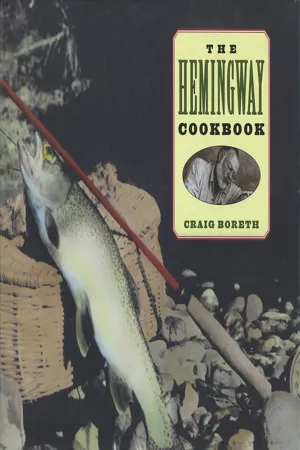
- 240 pages
- English
- ePUB (mobile friendly)
- Available on iOS & Android
eBook - ePub
The Hemingway Cookbook
About this book
Ernest Hemingway's insatiable appetite for life was evident in his writing and equaled by little else than his voracious appetite for good food and drink.
The Hemingway Cookbook collects, for the first time, more than 125 recipes from Hemingway's life and art featuring such unique dishes as Dorado Fillet in Damn Good Sauce, Woodcock Flambé in Armagnac, Campfire Apple Pie, and Fillet of Lion washed down with Campari and Gordon's Gin or a cool Cuba Libre. These pages are enriched by family photos, dining passages from stories such as
A Moveable Feast, The Old Man and the Sea, and
A Farewell to Arms, his short stories, personal correspondence, and even a contribution from his last wife Mary. Collecting recipes from former Hemingway haunts, period cookbooks, and other sources, this book is an authentic re-creation of the meals that enriched Hemingway's literature
Frequently asked questions
Yes, you can cancel anytime from the Subscription tab in your account settings on the Perlego website. Your subscription will stay active until the end of your current billing period. Learn how to cancel your subscription.
At the moment all of our mobile-responsive ePub books are available to download via the app. Most of our PDFs are also available to download and we're working on making the final remaining ones downloadable now. Learn more here.
Perlego offers two plans: Essential and Complete
- Essential is ideal for learners and professionals who enjoy exploring a wide range of subjects. Access the Essential Library with 800,000+ trusted titles and best-sellers across business, personal growth, and the humanities. Includes unlimited reading time and Standard Read Aloud voice.
- Complete: Perfect for advanced learners and researchers needing full, unrestricted access. Unlock 1.4M+ books across hundreds of subjects, including academic and specialized titles. The Complete Plan also includes advanced features like Premium Read Aloud and Research Assistant.
We are an online textbook subscription service, where you can get access to an entire online library for less than the price of a single book per month. With over 1 million books across 1000+ topics, we’ve got you covered! Learn more here.
Look out for the read-aloud symbol on your next book to see if you can listen to it. The read-aloud tool reads text aloud for you, highlighting the text as it is being read. You can pause it, speed it up and slow it down. Learn more here.
Yes! You can use the Perlego app on both iOS or Android devices to read anytime, anywhere — even offline. Perfect for commutes or when you’re on the go.
Please note we cannot support devices running on iOS 13 and Android 7 or earlier. Learn more about using the app.
Please note we cannot support devices running on iOS 13 and Android 7 or earlier. Learn more about using the app.
Yes, you can access The Hemingway Cookbook by Craig Boreth in PDF and/or ePUB format, as well as other popular books in Art & Culinary Arts. We have over one million books available in our catalogue for you to explore.
Information
1
THE EARLY YEARS
A Taste for Life
“Don’t be afraid to taste all the other things in life that aren’t here in Oak Park. This life is all right, but there’s a whole big world out there full of people who really feel things. They live and love and die with all their feelings. Taste everything, Sis.”
—Ernest to his sister Marcelline, 1919
A family portrait of the Hemingways in 1909.
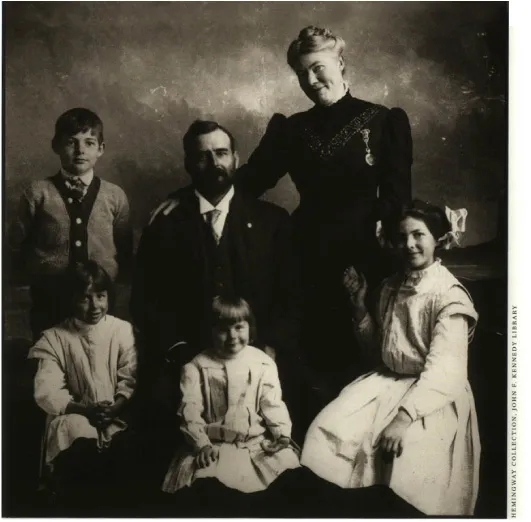
(Top row, left to right) Ernest, Ed, Grace, (bottom row) Ursula, Sunny, and Marcelline.
Ernest Miller Hemingway was born July 21,1899, and ate meat, vegetables, eggs, and fish shortly thereafter. His father, Dr. Clarence Edmonds Hemingway (known commonly as Ed), believed such foods were essential for nursing babies to grow up strong and healthy. His mother, Grace Hall Hemingway, lamented the decision. She noted in her daughter Marcelline’s baby book her annoyance at receiving the babies for nursing with onions on their breath.1
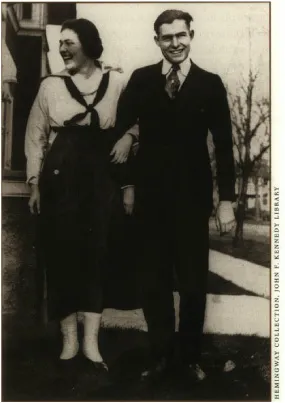
Ernest Hemingway and his sister Marcelline, 1916.
The Hemingways lived in the affluent and proper Chicago suburb of Oak Park. Grace Hemingway, once an aspiring opera singer, remained ambitious in her endeavors as a music teacher, suffragist, and painter. Mothering six children did not lessen her distaste for housework, and she continued her pursuit of the fine arts over the culinary arts. In fact, she was such a stranger to the kitchen that when she finally mastered a recipe from her mother’s cookbook, she decided to quit while she was ahead. When Marcelline suggested that she learn to make a layer cake, Grace replied, no doubt with chin up and eyes beaming, “I proved I could cook with my tea cake, and I’m not going to take a chance of spoiling my reputation by trying anything else.”2
This recipe is based on Grandmother Hall’s English tea cake recipe, which Grace contributed to the 1921 edition of the Oak Park Third Congregational Church Cookbook. The author would like to thank Jennifer Wheeler and the Ernest Hemingway Foundation of Oak Park for their generous assistance in obtaining this recipe.
Grace Hall Hemingway’s English Tea Cakes
The original recipe for these tea cakes is rather vague in its instructions. Grace shared the recipe with Liz Dilworth, the mother of Ernest’s best friend from upper Michigan, where the Hemingways had a summer cottage on Walloon Lake. The Dilworths lived in Horton Bay on Lake Charlevoix. Mrs. Dilworth, known as Aunty Beth to the Hemingway children, ran a small restaurant called Pinehurst Cottage, famous for its fried chicken dinners. Mrs. Dilworth worked out the exact proportions of the recipe and taught Grace how to prepare it. After secretly mastering the recipe at the Dilworths’, Grace finally prepared the hot bread in the Hemingway kitchen and served it with great pride and joy. Ed could hardly contain his praise: “Delicious! Grade, delicious!”3
12 SERVINGS (4 TO 6 9-INCH CAKES)
1½ teaspoons active dry yeast
½ teaspoon salt
1½ cups warm water (110° F)
4 cups all-purpose flour
1 tablespoon butter, melted
2 teaspoons lard or shortening
2 large eggs, beaten
½ cup plus 2 tablespoons sugar
¼ cup warm milk
1 cup dried currants or raisins
Plenty of extra melted butter for swathing
To set the sponge, whisk together the yeast, salt, and water in a mixing bowl for several minutes until the yeast is completely dissolved. Stir in l½ cups of the flour and mix until smooth. Cover with a towel and let stand in a draftfree space for 2 hours.
When the sponge has risen, stir in the butter and lard, along with the remaining flour, beaten eggs, sugar, milk, and currants or raisins. Mix thoroughly to form a stiff batter. Cover and let stand up to 1 hour.
Preheat the oven to 350°F.
Divide the batter evenly into four buttered pie tins and let rise for at least 2 hours. Bake in the center of the oven for about 20 minutes, or until golden brown. Remove the cakes to a cooling rack, brush with a lot of melted butter, cut into wedges, and serve while still warm.
Grace’s tea cake recipe was also published in The Nineteenth Century Women’s Club Historical Centennial Cookbook, along with a recipe for “Ernest Hemingway’s Cold Cucumber Soup.” Ernest’s connection with this sweet cucumber and leek broth is unclear, but here it is:
Ernest Hemingway’s Cold Cucumber Soup
4 TO 6 SERVINGS
3 cucumbers
1 tablespoon butter
1 tablespoon chopped fresh dill or mint
1 leek, white part only, sliced, or ¼ cup chopped onion
1 bay leaf
1 tablespoon all-purpose flour
2 cups fresh chicken stock or canned broth
1 teaspoon salt, or to taste
White pepper (optional)
1 cup half & half
Juice of ½ lemon
1 tablespoon honey (optional)
Peel and slice two of the cucumbers. Peel, seed, and grate the remaining cucumber. Heat the butter in a large, heavy saucepan. Add the sliced cucumbers and cook over low heat for a few minutes. Add the dill or mint, leek, and bay leaf and cook over low heat until tender, about 20 minutes. Stir in the flour and cook for a few more minutes, stirring constantly. Add the stock and salt and simmer gently for 30 minutes. Remove the bay leaf and let the mixture cool slightly. Purée the mixture, half at a time, in a blender or food processor. Return to the pan and add the white pepper to taste. Add the half & half, lemon juice, and honey; then taste and adjust the seasoning. Stir in the grated cucumber. Refrigerate until ready to serve. Serve in a chilled bowl.
Ed Hemingway extended the same moral sense of discipline and responsibility that ruled all aspects of his life to food and eating. He was a passionate outdoorsman, hunting a vast array of game for the Hemingway table. This was particularly useful when the family would retreat from Oak Park each summer to their cottage on Walloon Lake in upper Michigan. Dr. Hemingway would often stay behind to work at his family practice, but when he was out in the country he was truly in his element. He quickly began to share his passion with his young son.

Ernest at age 5 with his first gun.
Ed Hemingway believed in hunting for food and eating everything that he killed. So, in Ernest’s fourteenth summer, when Ernest and summertime chum Harold Sampson returned triumphant after hunting and killing a porcupine that had injured a neighbor’s dog, Dr. Hemingway did not shower them with praise as expected. Instead, in his typical firm and unforgiving tone, Dr. Hemingway made them eat the animal, which turned out to be “about as tender and tasty as a piece of shoe leather.”4
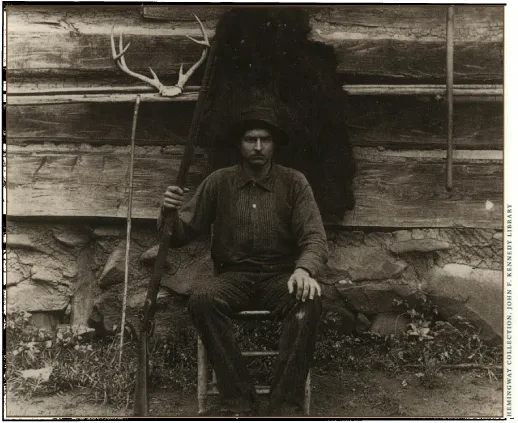
Ed Hemingway in the Great Smoky Mountains in North Carolina, 1891.
Ernest’s older sister Marcelline, in her memoir of those early years, At the Hemingways, shares one of her father’s anecdotes that displayed his skills and experience as a chef and outdoorsman. It is a story that Ernest no doubt heard repeatedly and loved, for details of Ed’s youthful adventure show up years later in his son’s early writings. It was not the last time that Ernest would take the stories of others and make them his own.
In the summer between his graduation from Oberlin College and his medical training at Rush Medical College in Chicago, Ed was asked to participate in a geological expedition in the Smoky Mountains. The expedition lasted longer than expected, and the supplies began to run low. Determined to provide a good meal (he was, after all, asked on the trip because he could cook), Ed shot some partridge and a few squirrels, coaxed honey from a bee’s nest, and whipped up a meal of fried game, biscuits, and blackberry pie. To his fellow campers’ amazement, Ed explained how he rolled out the piecrust using a beer bottle as a rolling pin.5
His father awakened Ernest’s love of the outdoors, of fishing and hunting, in those first summers on the lake. Ernest would eventually take that same, all-consuming passion for sport and adventure and apply it to the bullfights, deep-sea fishing, big game hunting, and virtually any endeavor upon which he embarked. As a young boy, though, the cottage door opened into deep woods, trout streams, campfires, and endless adventures. He saved the sights, sounds, and smells, as he would throughout his life. Eventually he would return through that same door, this time into his imagination, when his gift beckoned and he could not resist.
The summers in Michigan served Ernest in both his fiction and his journalism. In an early article for the Toronto Star, Ernest offered a howto guide to cooking in the bush. Later, in one of his finest short stories, he follows Nick Adams on a fishing trip to the “Big Two-Hearted River.” In both cases, he takes particular care to share the sensation of the foods.
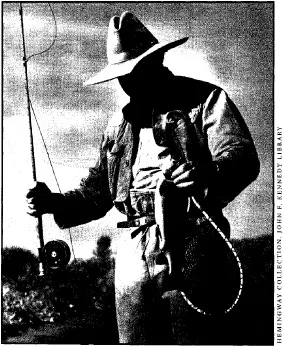
Trout fishing in Sun Valley, Idaho, 1939.
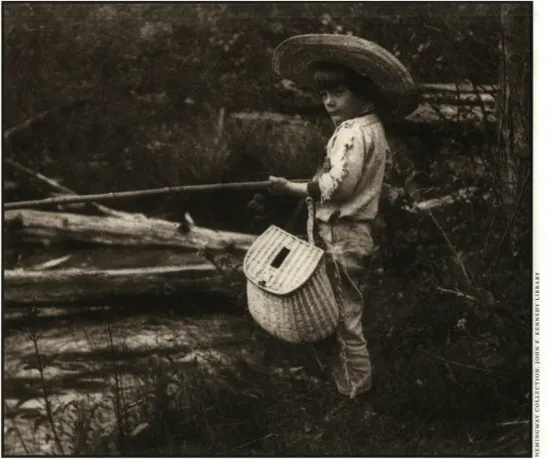
Hemingway trout fishing at Horton Creek, July, 1904.
Camping Out
In January 1920, Ernest traveled from Oak Park to Toronto to act as companion and tutor to the son of wealthy parents he met in Michigan while speaking on his wartime adventures. While there, he began writing for the Toronto Star, whose editor found Ernest’s straightforward prose and good humor perfect for the paper’s new direction. Young Hemingway had his own byline and received a penny a word for his articles. Hemingway would eventually work as a European correspondent for the Toronto Star during his time in Paris.
In his article “Camping Out: When You Camp Out, Do It Right,” Hemingway shows that, even as a very young man, he had a knack for writing with an air of gentle, humorous authority. When he lectures on exactly how to prepare a delicious meal in the bush, it seems only wise to listen carefully.
Fried Trout
Ernest loved trout fishing and he loved eating trout. He enthusiastically shared his pleasure with his earlier readers, as he would later do after visiting the Spanish Pyrenees (see Trucha a la Navarra, page 84) and Switzerland (see Trout au Bleu, page...
Table of contents
- Cover Page
- Title Page
- Copyright Page
- Dedication
- Introduction Dining with Hemingway Wild Gastronomic Adventures
- 1 The Early Years A Taste for Life
- 2 Italy Remembrance and War
- 3 France An Immovable Feast
- 4 Spain The Fiesta Concept of Life
- 5 Key West and Cuba Sailing the Stream
- 6 East Africa and Idaho A Hunter’s Culinary Sketches
- 7 The Hemingway Wine Cellar
- 8 The Hemingway Bar
- Epilogue An After-Dinner Treat The Fable of the Good Lion
- Notes
- Bibliography
- Acknowledgments
- General Index
- Recipe Index
- Back Cover